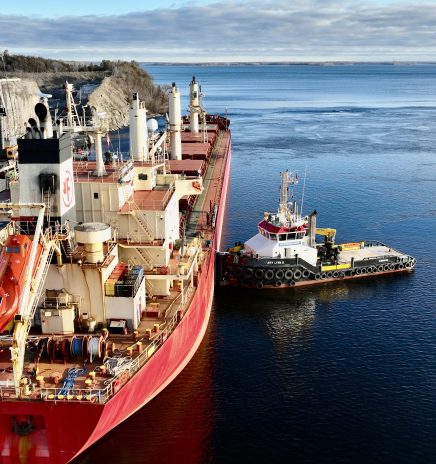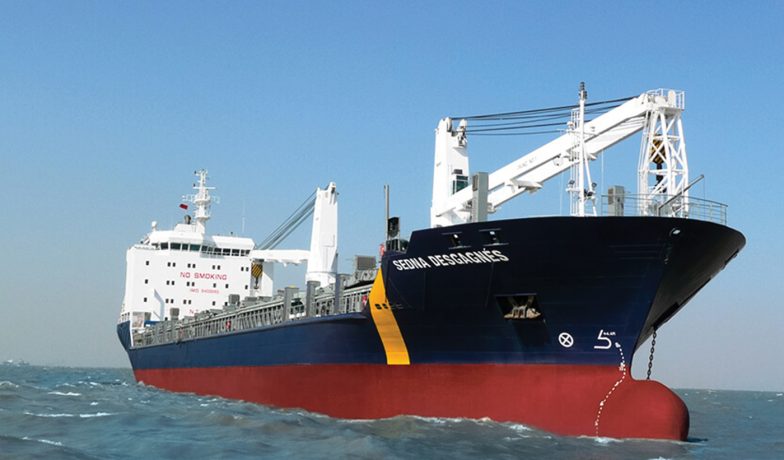Year One: Hamilton Container Terminal Launches Canadian Feeder Line
The service is a partnership between HCT, the Hamilton-Oshawa Port Authority (HOPA Ports) and Desgagnés. Launching from Pier 14 June 10, Sedna Desgagnés carried nearly 300 containers from Hamilton to the Port of Montreal, the lines designated route. While the ship didn’t have a backhaul, there’s now enough cargo lined up for a series of back-to-back sailings from late October through December, says Sanjeev Saraf, commercial director for Hamilton Container Terminal
For this next phase, HCT will lease the general cargo ship Acadia Desgagnés. The feeder vessel can carry approximately 350 containers originating in the Greater Toronto-Hamilton Area from Hamilton.
The containers are filled with diverse cargoes, including steel, grain, used automobiles, used clothing and wine. The boxes are transloaded in Montreal to other vessels destined for overseas ports. The Indian subcontinent in Asia is an anchor destination.
Since establishing at the Port of Hamilton in 2015, HCT has been building the container handling business – preparing for the recent launch.
“We have been creating the business ecosystem to bring this service to life,” says HCT President Amandeep Kaloti. “We have invested in infrastructure and established the right partnerships for it to succeed.”
In addition to Desgagnés and HOPA Ports, regional partners include MSC, Federal Marine Terminals as the terminal operator and Avancer International Freight Systems as freight forwarder.
HOPA Ports President & CEO Ian Hamilton says he believes HCT is tapping into a wider shift that is creating new opportunities for Great Lakes shipping.
“Highway congestion, greenhouse gas reduction targets, driver shortages – all of these factors are combining, so marine is making more sense for short journeys than ever before,” he adds. In choosing the marine mode, shippers will be reducing their CO2 footprint by as much as 500% versus surface transportation.
“We know there is a demand in the market for more sustainable, efficient and competitive options for container movements, and we are proud to help HCT launch this forward-looking solution,” Hamilton adds.
HCT’s goal is to simplify ocean container logistics and transportation by offering end-to-end services. Once a customer expresses interest, the staff customizes the logistics plan, which can include container storage and trading, multi-modal transport, maintenance and repair, weighment facility, fumigation with stuffing and lashing, consolidation and the equipment is taken to load and unload.
“We’re working hard to fill the service,” Saraf says. “We are the first feeder service coming out of Canada with containers and Montreal is one of the biggest gates.”
Targeting Liquid Bulk
HCT is canvasing the companies which export liquid bulk cargo with its flexitanks solution, a container liner discovered in the agri-food boom. Flexitanks are large polyethylene bags that can be filled with liquid bulk – like the wine being moved by HCT. With 407 wineries in British Columbia and Ontario, Saraf says HCT is communicating the benefits of exporting wine in bags that fill a 20-foot shipping container.
Traditional bottle shipping can fit about 12,000 bottles of wine per truck. A flexitank can hold about 35,000 bottles worth of wine per container – nearly three times the wine. Contents are kept at proper temperatures and the single use bags are ideal for the sanitation required for food products.
What’s Next?
With the remainder of 2021 being scheduled, HCT is looking ahead. Within the next few years, the company plans to strengthen its customer draw with custom-bonded warehousing, full container storage, reefer maintenance and repair, automotive logistics, rail service as well as stuffing, destuffing and lashing and more.
Beyond local services, HCT has its future focus on adding Halifax, Nova Scotia as a secondary destination for the feeder line.

Unlocking the Seaway’s Potential
Stakeholders have long said that the Great Lakes-St. Lawrence Seaway has the potential to increase service and contribute even more to North American trade and the international maritime industry. From efforts to expand container service to... Read More

Winding Down
As the Great Lakes-St. Lawrence Seaway System approaches its seasonal closure, the rhythm of maritime commerce slows. The Montreal–Lake Ontario section will cease transits after December 24, with all ships required to clear... Read More

